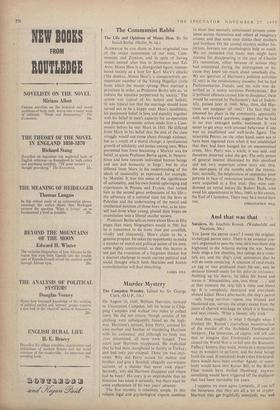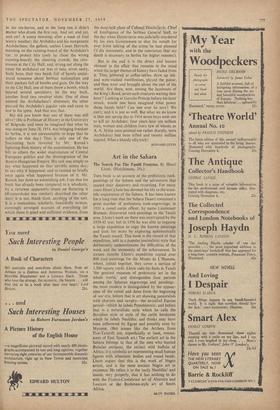And that was that
You know the parrot story? I mean the original. archetypal parrot story. There is an amateur con- cert, organised to pass the time, on a merchant ship fogbound in the Atlantic during the war. Some- body sings a few shanties, two ratings do a cross- talk act, and the ship's cook announces that he will do some conjuring. A selection of card-tricks, an egg or two produced from his ear, and he declares himself ready for his piece de resistance. Nothing up his sleeve; he takes his wand and waves it. 'Abracadabra, one, two, three . . ,' and at that moment the ship hits a mine and blows up. It is completely destroyed and everybody aboard killed. Hours afterwards, the ship's parrot —sole living survivor—opens one bruised and blackened eye, surveys the empty ocean from the piece of charred wreckage on which it is floating. and says crossly; 'What a bloody silly trick.'
And that, roughly, is what I thought when I finished Mr. Remak's marvellous reconstruction of the murder of the Archduke .Ferdinand at Sarajevo. The historians, of course, will tell you that to imagine that Ferdinand's assassination caused the World War is to fall into the Romantic Fallacy; history, they insist. moves in a mysterious way its wonders to Perform, and the hour brings forth the man. If somebody hadn't shot Ferdinand, there would have been another Agadir, or some- body would have shot Kaiser Bill, or the British Fleet would have shelled Hamburg; anyway, something would have triggered off the explosion that had been inevitable for years.
I suppose we must agree (certainly, if you tell the historians that they are all a lot of crypto- Marxists they get frightfUlly annoyed); war was
in the tea-leaves, and in the long run it didn't matter who drank the first cup. And yet, and yet, and yet ! A sunny morning, after a week of foul wintry weather; the Archduke and his morganatic Archduchess; the gallant, useless Count Harrach, standing on the running-board of the Archduke's car, to protect him (only he chose the wrong running-board); the cheering crowds; the cere- monies at the City Hall; and, strung out along the route the archducal car was to take, seven nasty, boily boys, their tiny heads full of barely under- stood nonsense about Serbian nationalism and their pockets full of bombs and guns. On the way to the City Hall, one of them threw a bomb, which injured several spectators; on the way back, another fired two revolver shots. One of these entered the Archduchess's abdomen; the other pierced the Archduke's jugular vein and came to rest in his spine. And that was that.
But did you know that one of them was still alive? (He is Professor of History at the University of Belgrade, and since he imagined that what he was doing on June 28, 1914, was bringing freedom to Serbia, it is not unreasonable to hope that he suffers to this day.) That is only one of the fascinating facts revealed by Mr. Remak's lightning-flash history of the assassination. He has left to others the wider examination of Central European politics and the disintegration of the Austro-Hungarian Empire. His task was simply to say what happened on that terrible, sunny day; to say why it happened, and to remind us briefly once again what happened because of it. Mr. Remak has done an astonishing job. I see that his book has already been compared to a whodunit, by a reviewer apparently intent on flattering it (Rianiersholm was similarly described the other clay); it is not, thank God, anything of the sort. It is a meticulous, scholarly, beautifully written, cunningly arranged account of everything for which there is good and sufficient evidence, from the deep-laid plans of Colonel Dimitrijevic, Chief of Intelligence of the Serbian General Staff, to the day when Dimitrijevic was judicially murdered by his own Government to shut his mouth for ever from talking of the crime he had planned ('I die innocently, and in the conviction that my death is necessary to Serbia for higher reasons').
But in the end it is the direct and human element in the affair that remains in the mind when the larger themes of history have faded from it. They jabbered at coffee-tables, drew up ink- and wine-stained manifestoes, played the guitar, and then went and brought about the end of the world. Are there, now, among the layabouts of the King's Road, seven such creatures waiting their hour? Looking at Gavrilo Princip before his hour struck, would one have imagined what power those hands held? Can one ever be sure? We can't; and it is just as well. But what we do know is that one spring day in 1914 seven boys went out to kill an Archduke; four years later ten million men, women and children (very few of whom, as A. A. Milne once pointed out rather sharply, were Archdukes) had been killed and twenty million injured. What a bloody silly trick !
BERNARD LEVIN



























































 Previous page
Previous page